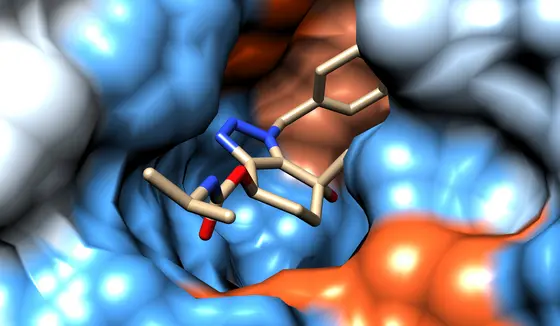“Over the past decades, the pharmaceutical industry has scaled back resources dedicated to the early stages of drug discovery. To develop innovative compounds, companies are now increasingly using new collaboration models with academic researchers,“ says Aubry Miller from the DKFZ, one of the conference organizers. “Therefore, universities and research institutions such as Helmholtz play an ever more important role in drug discovery.“
Following an invitation by the Drug Research Initiative in the Helmholtz Association, approximately 190 participants from research and industry will meet in Heidelberg to present recent findings and discuss new strategies.
The supply of urgently needed new drugs crucially depends on scientists unraveling misguided cellular processes or altered biomolecules, which are the underlying causes of individual diseases. These malfunctioning cellular components are the so-called “targets“ for new therapies, which drug molecules are designed to interfere with. Developing new drugs involves tremendous costs and, lamentably, many substance candidates that seem promising at first have to be abandoned in the clinical trials that follow. Therefore, it is critical to devise screening methods for new compounds that are as clinically relevant as possible.
Joe Lewis from theEuropean Molecular Biology Laboratory (EMBL) will present an example of this approach. He will talk about the search for substances against extremely malignant childhood brain cancers that feature characteristic mutations. In collaboration with Stefan Pfister (DKFZ and Heidelberg University Hopital), he developed a screening system that examines thousands of test substances in two different brain cancer cell lines that differ from each other in a single DNA mutation. The goal is to find specific agents that exclusively kill tumor cells that exhibit one of the two mutations and not the other one.
Many of our most important antibiotics have become ineffective due to resistance mechanisms and, therefore, urgently need to be replaced by novel classes of substances. Deniz Taşdemir from the Geomar Helmholtz Center and the University of Kiel considers the diversity of marine microorganisms, which is still largely unexplored, to be a promising source for new substances with antibiotic effects. She will talk about her plans to examine the chemically diverse
components of marine algae and fungi for their effectiveness against major pathogens.
The conference agenda also features the presentation of substances that are already in an advanced stage of drug development. Stefan Pusch (DKFZ) and Olaf Panknin (Bayer) will present one of these candidates, which will shortly be tested in a clinical trial. The substance specifically inhibits a particular type of mutation in an enzyme called IDH1 that frequently occurs in cancer cells and drives, for example, the growth of brain cancer and leukemia. The DKFZ is collaborating with Bayer in drug research: The company and the research center jointly identify promising candidates and then collaboratively develop them further.
So-called epigenetic mutations in DNA crucially determine which genes are available for “reading“ in a cell. Substances that influence epigenetic processes will play a major role in the treatment of cancer and also of neurodegenerative diseases in the future. They will therefore be addressed at the conference in a separate topic block.
Novel drugs based on small RNA molecules are also regarded as promising agents of the future and will be a topic at the conference. Examples include the minute siRNAs, which can be used to turn off specific genes, and so-called ribozymes – RNA molecules that can execute the function of enzymes and thus interfere with pathogenic cellular process.
Journalists are welcome to attend the conference.
Conference program:
https://www.helmholtz-hzi.de/de/aktuelles/veranstaltungen/ansicht/event/info/drug_innovation_in_academia/
A picture is available at:
Protein-Inhibitor-Complex.jpg
Caption: A compound binds to an enzyme and inhibits its function
Note on use of images related to press releases
Use is free of charge. The German Cancer Research Center (Deutsches Krebsforschungszentrum, DKFZ) permits one-time use in the context of reporting about the topic covered in the press release. Images have to be cited as follows: “Source: Aubry Miller, DKFZ“.
Distribution of images to third parties is not permitted unless prior consent has been obtained from DKFZ's Press Office (phone: ++49-(0)6221 42 2854, E-mail: presse@dkfz.de). Any commercial use is prohibited.
